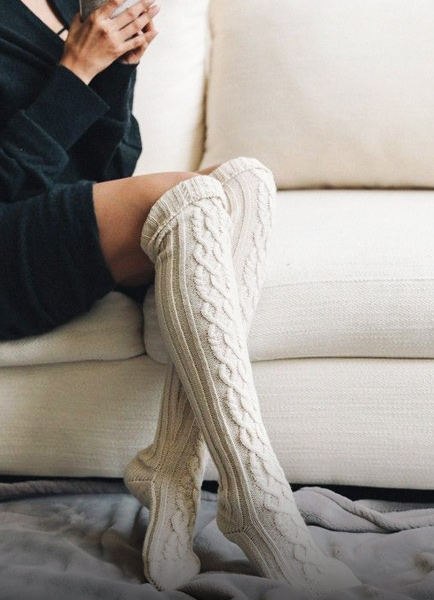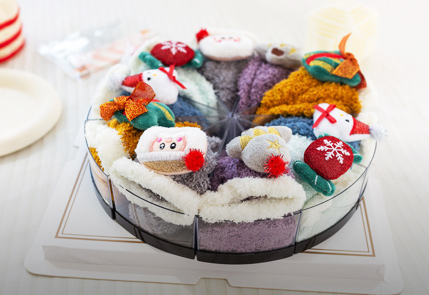Views: 0 Author: Site Editor Publish Time: 2025-03-20 Origin: Site









Welcome to Zhuji Jssox, your ultimate destination for high-quality and stylish lady socks! Whether you're looking for everyday comfort, athletic performance, or luxurious feel, choosing the right fabric is key to finding the perfect pair of socks. At Zhuji Jssox, we specialize in exploring the best materials to meet your needs. In this article, we will delve into the various fabrics used in lady socks, examining their unique benefits and drawbacks to help you make an informed decision.The fabric of your socks can significantly impact your comfort, durability, breathability, and overall foot health. Understanding the differences between materials is essential for selecting the best socks for your lifestyle. Let's explore the key factors to consider when choosing lady socks and the popular fabric choices available.
When selecting the best fabric for your lady socks, several factors should be taken into account:
Comfort: How does the fabric feel against your skin? Is it soft, smooth, or potentially irritating?
Durability: Will the socks withstand regular wear and tear without easily wearing out or losing shape?
Breathability: Can the fabric keep your feet cool and dry, preventing excessive sweating and discomfort?
Moisture Management: Does the fabric wick away sweat effectively, reducing the risk of blisters and fungal infections?
Temperature Regulation: Can the socks keep your feet warm in winter and cool in summer, adapting to different weather conditions?

Definition and Production: Organic cotton is grown without synthetic pesticides or fertilizers, making it an eco-friendly and hypoallergenic choice. This natural material is gentle on the skin and supports sustainable farming practices.Benefits:
Softness: Organic cotton is incredibly gentle on the skin, providing a soft and comfortable feel.
Breathability: It allows air to circulate freely, keeping your feet cool and dry.
Hypoallergenic: Suitable for those with sensitive skin, as it reduces the risk of allergic reactions.
Eco-Friendly: Choosing organic cotton supports sustainable and environmentally friendly practices.
Best For: Everyday wear, especially in warm weather conditions. Not Suited For: High-intensity activities or wet conditions, as it absorbs moisture and takes longer to dry.
Definition and Production: Merino wool is derived from Merino sheep, known for their fine, soft fibers. This natural material is renowned for its superior quality and performance.Benefits:
Excellent Insulation: Merino wool keeps your feet warm in cold weather and cool in warm conditions.
Moisture-Wicking: It effectively wicks moisture away from your skin, keeping your feet dry.
Odor-Resistant: Merino wool helps maintain fresh socks, even after extended use.
Soft and Non-Itchy: Despite being a wool product, Merino wool is incredibly soft and comfortable for prolonged wear.
Best For: Cold weather, outdoor activities, and long wear. Not Suited For: Hot weather or vegans, as it is an animal product.
Definition and Production: Bamboo is a fast-growing plant, making it an eco-friendly and sustainable choice. Bamboo fabric is derived from bamboo fibers, offering a luxurious feel.Benefits:
Softness: Bamboo fabric is incredibly soft and comfortable against the skin.
Breathability: It allows air to circulate, keeping your feet cool and dry.
Antimicrobial: Bamboo fabric naturally resists bacteria, reducing odor.
Eco-Friendly: Bamboo requires fewer resources to grow compared to other crops, making it a sustainable choice.
Best For: Everyday wear, especially in warm weather. Not Suited For: High-intensity activities or cold weather, as it may not provide sufficient insulation.
Types: Common synthetic fibers used in socks include nylon, polyester, and acrylic.Benefits:
Durability: Synthetic fibers are long-lasting and resistant to wear and tear.
Moisture-Wicking: They effectively keep your feet dry by wicking away moisture.
Quick-Drying: Synthetic fibers dry faster than natural materials, making them ideal for wet conditions.
Affordable: Generally more cost-effective than natural fibers.
Best For: Athletic wear, casual wear, and activities in wet conditions. Not Suited For: Sensitive skin or extreme temperatures, as they may lack breathability and can trap heat.
Definition and Production: Silk is a natural protein fiber produced by silkworms. It is known for its luxurious feel and elegant appearance.Benefits:
Soft and Smooth: Silk provides a luxurious, smooth feel against the skin.
Temperature Regulation: Silk keeps your feet cool in summer and warm in winter.
Hypoallergenic: Less likely to cause allergic reactions, making it suitable for sensitive skin.
Lightweight: Silk is comfortable and easy to wear.
Best For: Dress socks, sensitive skin, and mild weather. Not Suited For: Athletic activities or rough conditions, as it may not be durable enough.
Definition and Production: Blended fabrics combine natural and synthetic fibers to leverage the strengths of both materials.Benefits:
Versatility: Combines the benefits of multiple fibers.
Enhanced Performance: Improved durability, comfort, and moisture management.
Cost-Effective: Often more affordable than pure natural fibers.
Best For: Everyday wear, versatile use, and various weather conditions. Not Suited For: Specific allergies to certain fibers.
Materials: Alpaca, cashmere, spandex.Benefits:
Warmth: Exceptional insulation for cold weather.
Softness: Luxurious feel against the skin.
Elasticity: Spandex adds stretch for a snug fit.
Best For: Winter wear, luxury socks, and athletic wear. Not Suited For: Everyday wear due to higher cost.

Prioritize Natural and Organic Materials: Opt for breathable materials like organic cotton.
Adapt to Climate and Weather: Choose materials that provide warmth in cold weather and coolness in warm weather.
Manage Allergies and Sensitivities: Select hypoallergenic materials for sensitive skin.
Check for Cushioning and Support: Look for socks with extra cushioning and arch support to reduce foot fatigue.
The best fabric for lady socks depends on your individual needs and preferences. Whether you need socks for everyday wear, athletic activities, or special occasions, there is a fabric that will suit your requirements perfectly. Below is a comprehensive summary of the key features and suitability of each fabric:
| Fabric Type | Softness | Breathability | Durability | Moisture-Wicking | Temperature Regulation | Suitable For | Not Suited For |
|---|---|---|---|---|---|---|---|
Organic Cotton | High | High | Medium | Low | Medium | Everyday wear, warm weather | High-intensity activities |
Merino Wool | High | Medium | High | High | Excellent | Cold weather, outdoor activities | Hot weather, vegans |
Bamboo | High | High | Medium | Medium | Medium | Everyday wear, warm weather | High-intensity activities |
Synthetic Fibers | Medium | Low | High | High | Low | Athletic wear, wet conditions | Sensitive skin, extreme temperatures |
Silk | Very High | Medium | Low | Medium | Excellent | Dress socks, mild weather | Athletic activities |
Blended Fabrics | Medium | Medium | High | High | Medium | Everyday wear, various conditions | Specific allergies |
Specialty Socks | Very High | Medium | Medium | Medium | High | Winter wear, luxury socks | Everyday wear due to cost |
By considering these factors and understanding the unique properties of each fabric, you can make an informed decision and find the perfect pair of lady socks to meet your needs. At Zhuji Jssox, we offer a wide range of high-quality socks in various fabrics to ensure you get the best comfort and performance.